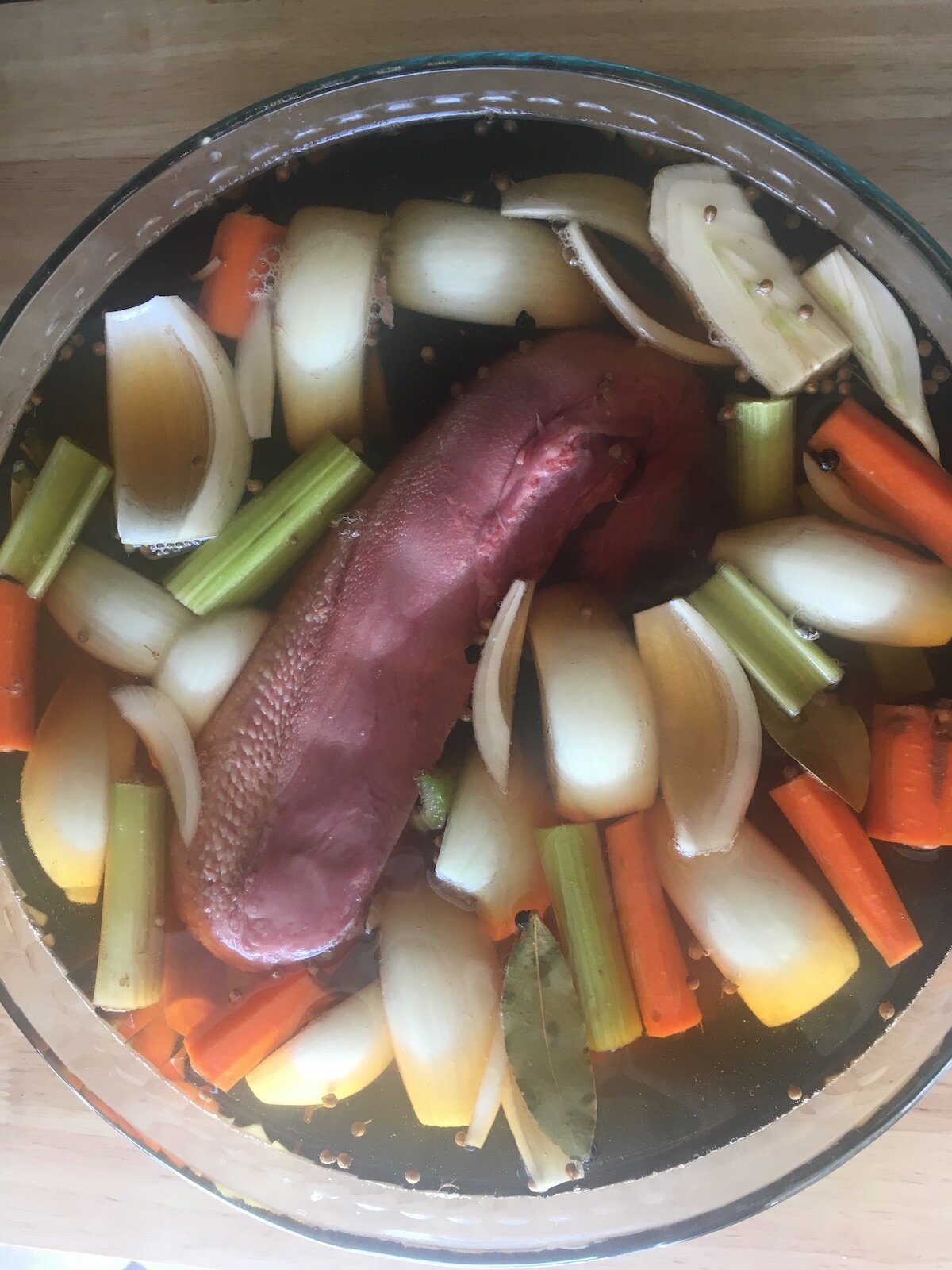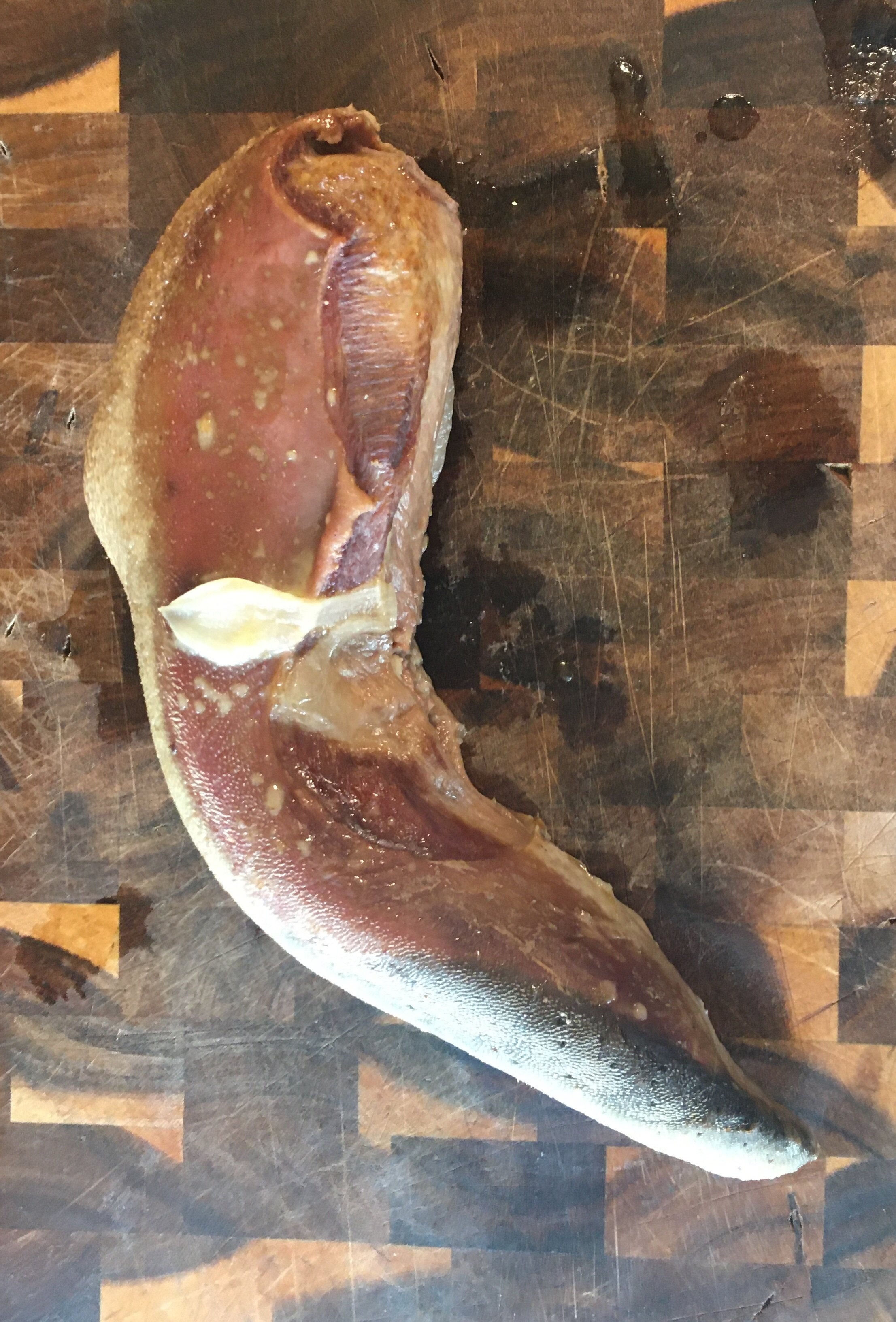Beef tongue hash, a family favorite.
Why Eat Grass Fed Beef Tongue
When making a bulk beef purchase like a ¼ or ½ cow, you often have the option to take home offal -- the less commonly known cuts of meat. This can include liver, heart, tongue, fat, tendon, kidney, and bones. For most of human history it was normal to eat the whole animal. Our ancestors prized organ meats for their nutrient density, and it’s only in recent years and in industrialized nations that muscle meat is the primary cut of meat eaten.
Grass-fed beef tongue is a rich source of zinc, iron, phosphorus, and B-vitamins (B12, B2, B3, and B6). It’s very tender and can have a “game-y” taste if not prepared with a brine, as included below.
Tongue hash served up with eggs.
About this Preparation
This method is my favorite preparation of beef tongue because the brine removes all “game-y” and offal-esque flavor from the tongue and helps to further tenderize and imbue the tongue with subtle flavor. The taste and texture are akin to a well-prepared brisket, but even more tender. I truly doubt most people would know they were eating tongue if served this dish.
The key is to brine for 5-7 days, covered, in the refrigerator. After 2-3 days, flip the tongue in the brine to help with even soaking. I skipped the brining step once and didn’t enjoy the flavor nearly as much. After brining, the tongue is poached for several hours and then is ready to be used in the skillet hash. The skillet hash is a combination of fried potatoes and peppers with poached and seared tongue.
This recipe is an amalgamation of the tongue preparations in The Meateater Fish and Game Cookbook by Steven Rinella and Odd Bits: How to Cook the Rest of the Animal by Jennifer McLagan.
INGREDIENTS
For the brine:
12 cups cold water (may need more)
1 cup salt
1 cup sugar
1 Tbsp whole black peppercorns
1 Tbsp whole coriander seeds
1 tsp whole mustard seeds
2 whole cloves
1 bay leaf
2 carrots, peeled and cut into chunks
2 stalks celery, cut into chunks
1 onion, quartered
8-10 cloves garlic, peeled
For the hash:
5-6 Tbsp cooking fat (bacon grease recommended)
2-4 potatoes, chopped into bite-size pieces
1 cup peppers, sliced (I used bell pepper but any peppers will do)
4-6 eggs, optional
Salt and pepper
METHOD
In a small pot, add all brine ingredients from 4 cups of water through the bay leaf and bring to a boil. Reduce and simmer uncovered for 3-5 minutes, until salt and sugar are dissolved.
Transfer brine to large glass bowl. When cooled, add 8 cups of water and remaining brine ingredients. Refrigerate for 5-7 days, flipping the tongue once halfway through.
Tongue brining. She’s a beaut!
After brining is complete, preheat oven to 300 F. Strain the tongue, reserving the spices, and put the tongue and spices into a Dutch oven. Add enough water to cover the tongue and bring to a boil.
3. Turn off the burner, cover the Dutch oven and transfer to the oven. Cook until the tongue is very tender, 4 to 5 hours. Check tenderness by gently poking the tongue with a paring knife to feel its firmness.
4. Remove tongue from water and let cool. Then use a paring knife to remove the outer skin and chop into bite-sized pieces.
Poached tongue, ready to peel.
6. Heat a heavy-bottomed skillet over medium-high heat and add 2-3 Tbsp cooking fat of choice. When it’s searing hot, add chopped potatoes and let them be (for a few minutes)! The key to crispy fried potatoes is to resist flipping them until they are adequately browned on one side. After 5-7 minutes, flip the potatoes and finish cooking. When the potatoes are cooked, remove from skillet and season with salt. I season with salt last because salt draws out moisture from the potatoes, and moisture is the enemy of crispy potatoes.
Potatoes frying in bacon grease.
7. Add another 2-3 Tbsp cooking fat to skillet on medium-high heat. When it’s very hot, add chopped tongue and sear on all sides, 1-2 minutes each side. Tongs are ideal for flipping each piece of tongue. Remove from skillet and set aside.
Tongue frying in bacon grease.
8. Add peppers to skillet and cook 2-3 minutes.
9. When peppers are cooked, transfer potatoes and seared tongue to skillet and season with salt and pepper. Warm up the hash on medium-low for 3-5 minutes. Serve immediately.
Hash, ready to serve.
10. Optional: Fry an egg (or two) for each serving.
Tongue hash served up with eggs.
SERVING SUGGESTIONS
Sour cream
Salsa or hot sauce
Chopped green onions or chives
Enjoy this delicious preparation of grass-fed beef tongue! If you try this recipe, let us know by tagging us on Instagram or Facebook.











































